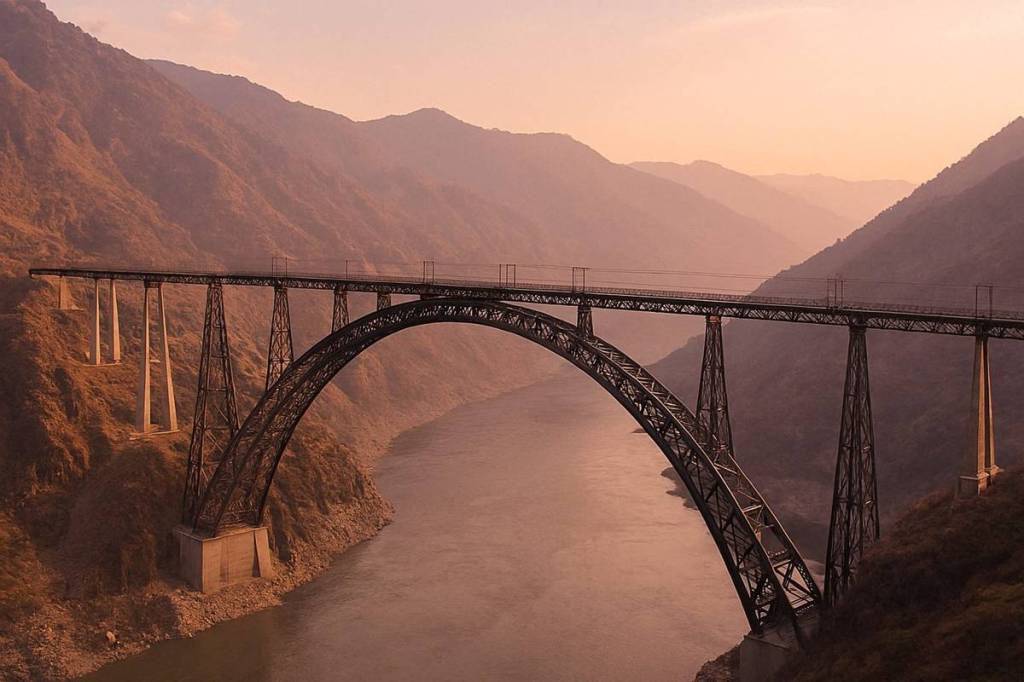Prime Minister Narendra Modi is set to inaugurate the Chenab Rail Bridge on Friday, June 6, in Jammu and Kashmir’s Reasi district — a towering steel marvel that’s part of the 272-km Udhampur-Srinagar-Baramulla Rail Link (USBRL) project. He will also flag off two Vande Bharat trains between Katra and Srinagar. The bridge, touted as the world’s highest railway arch, is more than just a structural achievement — it’s a strategic, economic, and social lifeline. Here are ten reasons why this infrastructure milestone is so significant:
1. World’s highest railway arch bridge
The Chenab Rail Bridge rises 359 metres above the riverbed, making it taller than the Eiffel Tower by 35 metres. Built across a gorge in Reasi district, it holds the distinction of being the highest railway arch bridge globally. Its imposing 1,315-metre length and steel arch of 467 metres are engineering marvels that command global admiration.
2. Connecting Jammu with Srinagar and Baramulla via Reasi
The bridge is a key element of the USBRL project, a 272-km railway line aimed at connecting Jammu with Srinagar and Baramulla via Reasi. With 255 km already completed, this all-weather rail link will reduce the Valley’s dependence on the vulnerable Srinagar-Jammu highway, ensuring year-round connectivity. The Vande Bharat Express between Katra and Srinagar promises faster travel and enhanced comfort and deeper connectivity for Jammu and Kashmir’s people, economy, and tourism sector.
3. Engineering marvel for extreme weather in J-K
Constructed at a cost of around Rs 1,400 crore, the Chenab Bridge is designed to endure wind speeds of up to 260 kmph and seismic activity. With a 120-year design life, it is also blast-resistant — capable of withstanding explosions of up to 40 kg of TNT.
4. Anji Bridge
Alongside Chenab, PM Modi will also inaugurate the Anji Bridge — India’s first cable-stayed rail bridge. The bridge spans the deep Anji River valley, south of the Chenab, connecting the Katra Banihal section of the Udhampur Srinagar Baramulla Rail Line.
It is supported by 48 cables and spans 473 metres. At 331 metres high, it is the second-tallest rail bridge in India. Like Chenab, it overcomes extreme terrain to ensure safe passage across the rugged landscape.
5. Bridge game-changer for military mobility
The rail link will provide strategic advantage by allowing the rapid movement of military personnel and supplies to border areas — even in harsh weather. This is crucial given the region’s proximity to sensitive international borders.
6. Boost to local economy and trade
By connecting the Valley with the rest of India, the USBRL will unlock trade opportunities. Kashmiri apples, saffron, handicrafts, and dry fruits will have faster, more reliable routes to reach major markets, bolstering the region’s economy.
7. Boosting tourism
With improved access and reduced travel times, the region is expected to see a significant increase in tourism. Cheaper and faster rail travel could especially help revive the sector after recent incidents like the Pahalgam terror attack. A direct Katra-Srinagar Vande Bharat train could become a preferred route for pilgrims and tourists alike.
8. All weather connectivity
The Srinagar-Jammu highway, currently the only road link, often shuts down due to snowfall or landslides. The USBRL provides an all-weather alternative, shielding essential connectivity from natural disruptions.
9. Reduces travel time
Once fully operational, the railway will cut down travel time between Jammu and Srinagar from six hours by road to just 3 to 3.5 hours by train. It will make daily commutes, logistics, and even emergency services more efficient.
10. USBRL connects remote J-K to national rail network
The Udhampur–Srinagar–Baramulla Rail Link features 36 tunnels covering 119 kilometres and 943 bridges that span valleys, ridges, and mountains. Engineered to conquer the region’s difficult terrain, it connects remote parts of Jammu and Kashmir to India’s national rail network.

